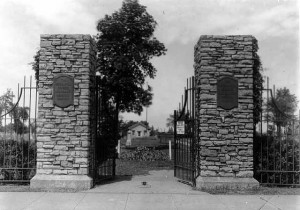
Layman”'s Cemetery Gates, ca. 1936. Photo courtesy of the Minnesota Historical Society. The restored gates on the Cedar Avenue and Lake Street sides of the cemetery as well as the section of fence behind the Cedar Avenue bus stop are off to the shops to be restored. They are scheduled to be reinstalled on, or around, December 10th. We are still raising working on raising funds to restore the remaining sections of the fence.
by Sue Hunter Weir
In 1909, when she was 15 years old, Ruth Neff was arrested for indecent conduct. After that, things went straight down hill. She was sent to a reform school for a few months but her mother managed to persuade the court to let Ruth out on parole. According to her mother, Ruth had always been a difficult child. Ruth”'s parents separated shortly after she was born because, in the words of her mother, Ruth”'s father had become “more or less dissipated.” In order to support herself and her four children, Ruth”'s mother had to work. Ruth did poorly in school and often skipped class. One of her teachers described Ruth “as not quite normal mentally.” The same teacher admitted that they”'d promoted Ruth “to simply get her on in school.” Even so, Ruth never got beyond the fourth grade.
After Ruth was released from reform school, she went to work in a laundry. During the summer months, her mother lived out at Lake Minnetonka where she had a job working in a resort. Ruth stayed at home with her grandmother and her three older brothers. Ruth”'s mother said that the grandmother was “a good woman but had little or no patience with Ruth after her delinquency and would not make it pleasant for the girl.” Ruth painted a much harsher picture of her grandmother, claiming that her grandmother had “told her to go out on the street and earn money.” Regardless of which account was true, Ruth got pregnant and was sent to the Cody Maternity Hospital where she gave birth to a “blue baby.” The baby died and was buried in Layman”'s Cemetery.
The following year Ruth got pregnant again. She said that she lost the baby because she took drugs. The year after that, Ruth got pregnant for a third time. That baby, a boy, lived but was a sickly child. He was viewed as a burden, not only by Ruth, but by her mother and grandmother. Ruth”'s mother made arrangements with a minister for the baby to be put up for adoption. In the meantime, Ruth took the baby and went to White Bear Lake to see about a housekeeping job. The woman who interviewed her made it clear””Ruth was welcome but her baby was not. Ruth later would claim that the woman told her that if she got rid of the baby, “she could have nice clothes, go to dances and have a good time generally and”¦that the way that they would do this, would be be inviting men to the house for immoral purposes.”
Ruth left. It is not clear whether she intended to return or not, but on the way home, she passed through some woods. She laid her baby down and went home without him. She met her mother on the street, and when her mother asked Ruth where the baby was, Ruth told her that the lady in White Bear Lake was going to adopt him. They continued talking as they walked home but her mother noticed that “Ruth was not in her right mind, that she talked in a wandering way about different things.” Shortly after they arrived home, the police came and arrested Ruth. Her baby had died of exposure.
Ruth pleaded guilty to a charge of manslaughter and was sent to Stillwater Prison. The details of her life up to the time of her arrest come from Ruth”'s prison case file. Her file also contains what may have been the start of a more stable life for Ruth. After serving about a year and a half in prison, Ruth was released in her mother”'s custody. She was placed on probation and was required to report to prison authorities every month. Not long after she was paroled, Ruth requested permission to get married. Through a friend of her mother”'s, she had met a young man, the youth director at a church camp. He knew about Ruth”'s past but still wanted to marry her. He provided the prison warden with references, all attesting to the fact that he was a “good man” who would make a good husband for Ruth. We can only hope that it turned out that way.









